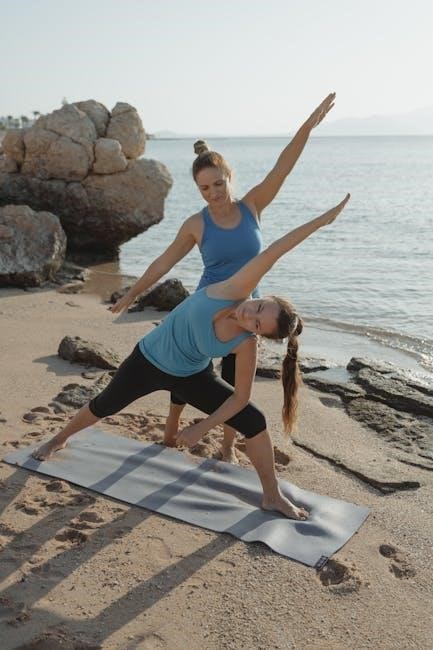
de quervain’s tenosynovitis exercises pdf
De Quervain’s Tenosynovitis is a condition affecting the tendon sheath on the thumb side of the wrist, causing pain and swelling. It often results from repetitive hand movements. Exercises and splints are key treatments, with downloadable PDF guides offering structured rehabilitation plans to alleviate symptoms and restore hand function effectively.
What is De Quervain’s Tenosynovitis?
De Quervain’s Tenosynovitis is a condition that affects the tendon sheath on the thumb side of the wrist. It occurs when the tendons become inflamed or irritated, leading to pain and swelling in the area. This condition often results from repetitive hand movements or activities that involve the thumb and wrist. The tendon sheath thickens, causing friction and discomfort during movements like gripping or twisting. Symptoms include pain near the base of the thumb, swelling, and difficulty moving the thumb or wrist. If left untreated, it can worsen and limit daily activities. This condition is common among individuals who perform repetitive tasks or have experienced direct injury to the wrist or thumb. Understanding the causes and symptoms is essential for effective treatment, which often involves exercises and splints to reduce inflammation and restore function.
Why Exercises Are Important for Treatment
Exercises play a crucial role in the treatment of De Quervain’s Tenosynovitis as they help reduce inflammation, improve mobility, and strengthen the muscles around the wrist and thumb. Gentle stretching and strengthening exercises can alleviate pain and restore function, making daily activities easier. These exercises target the tendons and surrounding tissues, promoting healing and preventing further irritation. By improving flexibility and reducing stiffness, exercises help restore normal movement to the wrist and thumb. Additionally, they enhance blood flow, which aids in the recovery process. Regular exercise routines can also prevent recurrence by strengthening the affected area and improving joint stability. Exercises are often recommended as a non-invasive and cost-effective first-line treatment. When combined with rest and splinting, they can significantly reduce symptoms and improve quality of life. Consistency in performing these exercises is key to achieving long-term relief and full recovery from De Quervain’s Tenosynovitis.
General Principles of De Quervain’s Tenosynovitis Exercises
Gentle stretches, strengthening exercises, and proper techniques are essential to promote healing and avoid further irritation. Exercises should be performed slowly and controlled to maximize benefits and minimize discomfort.
Understanding the Role of Physical Therapy
Physical therapy plays a crucial role in managing De Quervain’s Tenosynovitis by improving joint mobility and tendon flexibility. Techniques include passive stretches, isometric exercises, and gradual strengthening to reduce inflammation and restore function. A tailored approach ensures exercises are adapted to individual needs, promoting healing without aggravating symptoms. Regular sessions can prevent recurrence and enhance hand dexterity, making daily activities easier. Therapy also focuses on educating patients on proper wrist and thumb alignment to avoid repetitive strain. Over time, consistent physical therapy can significantly reduce pain and improve overall wrist and thumb function, allowing patients to return to normal activities without discomfort or limitation.
Avoiding Pain During Exercises
Avoiding pain during exercises is essential to prevent worsening symptoms and promote healing in De Quervain’s Tenosynovitis. Gentle, controlled movements are key, as forceful or painful motions can exacerbate inflammation. It’s important to stop any exercise if pain arises and rest the wrist and thumb. Applying heat to the area before starting exercises can help reduce stiffness and discomfort. Exercises should be performed slowly and within a pain-free range of motion. If pain persists, a wrist and thumb splint can be used to immobilize the area during activities. Gradually increasing the intensity of exercises ensures the tendons are not overstrained. Listening to your body and avoiding repetitive or aggravating movements is crucial for a successful recovery. Consistent, gentle practice helps restore function without causing further irritation.
Preventing Recurrence Through Exercise
Preventing recurrence of De Quervain’s Tenosynovitis requires consistent exercise and attention to proper hand and wrist mechanics. Regular stretching and strengthening exercises help maintain tendon flexibility and reduce the risk of re-injury. Focus on activities that promote wrist and thumb mobility, such as radial deviation stretches and thumb flexion exercises. Avoid repetitive gripping or twisting motions that strain the tendons. Modifying daily activities to reduce stress on the wrist and thumb is also crucial. For example, using ergonomic tools or taking regular breaks during repetitive tasks can make a significant difference. Strengthening the forearm and hand muscles provides additional support to the tendons, lowering the risk of recurrence. Over time, these exercises can help restore normal function and prevent future flare-ups, ensuring long-term recovery and reducing the likelihood of the condition returning.

Specific Exercises for De Quervain’s Tenosynovitis
Key exercises include opposition stretches, wrist radial deviation, and thumb flexion; These activities target the affected tendons, improving mobility and strength. A downloadable PDF guide provides clear instructions and progress tracking.
Opposition Stretch
The opposition stretch is a foundational exercise for De Quervain’s Tenosynovitis, targeting the thumb and wrist; To perform, place your hand flat on a table, palm up. Gently touch the tip of your thumb to your little finger, forming a light grip. Hold this position for 6-10 seconds, then release. Repeat 10 times per session, ideally 3 times daily. This stretch helps reduce stiffness and improves thumb mobility. It’s essential to avoid pain during the stretch; only gentle tension should be felt. For detailed guidance, refer to the downloadable PDF guide, which includes visual aids and step-by-step instructions to ensure proper form and maximum benefit.
Wrist Radial Deviation Stretch
The wrist radial deviation stretch is a key exercise for managing De Quervain’s Tenosynovitis, focusing on improving wrist mobility and reducing tension in the affected tendons. To perform this stretch, sit or stand with your arm extended in front of you at shoulder height. Gently tilt your wrist upward, sliding your hand toward your little finger until a mild stretch is felt on the thumb side of your wrist. Hold this position for 15-30 seconds, then slowly return to the starting position. Repeat 3-5 times per session, ideally 2-3 times daily. This exercise helps restore normal wrist movement and reduces stiffness. It’s important to perform the stretch slowly and avoid forced movements that might worsen symptoms. For visual guidance and detailed instructions, refer to the downloadable PDF guide, which provides clear illustrations and tips for proper technique.
Wrist Flexion Strengthening
Wrist flexion strengthening is a crucial exercise for addressing De Quervain’s Tenosynovitis, targeting the muscles responsible for wrist movement and grip. To perform this exercise, hold a light weight (less than 1 pound) or a resistance band in your hand with your palm facing upward. Sit with your forearm resting on your thigh or a flat surface, keeping your wrist and hand hanging freely. Slowly bend your wrist upward, lifting the weight toward your forearm, then lower it back to the starting position. Aim for 3 sets of 10-15 repetitions, 2-3 times daily. This exercise strengthens the flexor muscles, improving wrist stability and reducing strain on the tendons. Be sure to use light resistance to avoid aggravating the condition. For detailed instructions and progression tips, consult the downloadable PDF guide, which offers step-by-step visuals and modifications to suit different stages of recovery.
Wrist Extension Strengthening
Wrist extension strengthening is an essential exercise for managing De Quervain’s Tenosynovitis, focusing on the muscles that control wrist upward movement. To perform this exercise, hold a light weight (less than 1 pound) or resistance band in your hand with your palm facing downward. Sit with your forearm resting on your thigh or a flat surface, keeping your wrist and hand hanging freely. Slowly lift the weight by bending your wrist upward, then lower it back to the starting position. Aim for 3 sets of 10-15 repetitions, 2-3 times daily. This exercise strengthens the extensor muscles, improving wrist mobility and reducing tendon strain. Use light resistance to avoid pain and gradually increase as strength improves. For progression tips and visual guidance, refer to the downloadable PDF guide, which provides detailed instructions and modifications tailored to different recovery stages. Consistent practice enhances wrist stability and alleviates symptoms effectively.
Grip Strengthening Exercises
Grip strengthening exercises are crucial for rebuilding hand and wrist strength in individuals with De Quervain’s Tenosynovitis. One effective exercise involves placing a rubber band around the fingers, just below the fingertips. Slowly open the hand against the resistance of the band, holding for 5 seconds before releasing. Repeat this 10-15 times for 3 sets daily. Another option is to squeeze a small, soft ball for 5-10 seconds, releasing slowly, and repeating 10-15 times in 3 sets. These exercises target the intrinsic hand muscles and improve grip endurance without overloading the tendons. Start with low resistance and gradually increase as strength improves. For progression, incorporate light weights or resistance bands. Perform these exercises 2-3 times daily, ensuring pain-free movements. For detailed instructions and variations, refer to the downloadable PDF guide, which offers step-by-step visuals and modifications to suit different recovery stages. Consistency in these exercises enhances grip strength and supports overall wrist function. Always prioritize pain-free ranges and avoid overexertion to promote healing and prevent recurrence.
Thumb Flexion and Extension
Thumb flexion and extension exercises are essential for improving mobility and strength in individuals with De Quervain’s Tenosynovitis. To perform thumb flexion, gently bend your thumb toward your palm and hold for 5 seconds. Slowly return to the starting position. Repeat this 10-15 times in 3 sets daily. For extension, stretch your thumb away from your palm as far as comfortable, holding for 5 seconds before lowering it back. Perform 10-15 repetitions in 3 sets. These exercises can be done passively by using the unaffected hand to guide the thumb through the motions if active movement is painful. Avoid forcing the thumb beyond a pain-free range to prevent aggravation. Gradually increase the range as comfort allows. For variations, incorporate light resistance using a rubber band or small weight. Consistency in these exercises helps restore thumb function and reduces stiffness. Refer to the downloadable PDF guide for illustrated instructions and progression tips to ensure proper technique and safety.
Passive Wrist Flexion and Extension
Passive wrist flexion and extension exercises are designed to improve wrist mobility without active muscle engagement, making them ideal for individuals with De Quervain’s Tenosynovitis who may experience pain during movement. To perform passive wrist flexion, use your unaffected hand to gently lift the affected wrist upward, holding for 5-10 seconds. Slowly lower the wrist back to the starting position. Repeat this 10-15 times in 3 sets daily. For extension, use your unaffected hand to guide the affected wrist backward, holding for 5-10 seconds before returning to the neutral position. Perform 10-15 repetitions in 3 sets. These exercises should be done within a pain-free range to avoid aggravating the condition. Avoid bouncing or forcing the wrist beyond a comfortable range. Applying heat to the wrist before exercises can help relax the muscles and improve flexibility. Regular practice of these exercises can help restore wrist motion and reduce stiffness. For detailed instructions, refer to the downloadable PDF guide.
Isometric Wrist Exercises
Isometric wrist exercises are a cornerstone in the rehabilitation of De Quervain’s Tenosynovitis, offering a gentle yet effective way to strengthen the wrist and thumb muscles without joint movement. These exercises are particularly beneficial during the acute phase, as they minimize stress on the inflamed tendons. To perform isometric wrist flexion, sit with your forearm resting on your thigh, palm facing up. Use your other hand to apply resistance, pushing your wrist downward while contracting the muscles in your forearm. Hold for 10 seconds, then relax. Repeat 8-10 repetitions, 3 times daily. For wrist extension, follow the same steps but with your palm facing down, resisting upward movement. Additionally, isometric thumb exercises can be incorporated by wrapping a rubber band around your thumb and gently pulling against it while holding for 5-10 seconds. These exercises improve muscle strength and endurance without exacerbating the condition. For detailed guidance, refer to the downloadable PDF guide;

Rehabilitation Phases
Rehabilitation for De Quervain’s Tenosynovitis is divided into phases: acute, subacute, and maintenance. Each phase focuses on reducing pain, restoring mobility, and strengthening the wrist and thumb, guided by exercises outlined in the downloadable PDF.
Phase 1: Acute Phase Exercises
The acute phase of De Quervain’s Tenosynovitis rehabilitation focuses on reducing pain and inflammation while initiating gentle mobilization. During this phase, passive wrist flexion and extension exercises are often recommended, where the unaffected hand assists in moving the painful wrist through a pain-free range. Opposition stretches and isometric exercises are also introduced to maintain thumb mobility and strength without aggravating the condition. It is crucial to avoid any activities that worsen symptoms and to apply heat before exercises to promote relaxation of the tendons. Splints may be used to immobilize the thumb and wrist, reducing strain on the tendon sheath. Exercises should be performed 2-3 times daily, with each session lasting 5-10 minutes. Progress is monitored to ensure pain remains controlled, allowing for a gradual transition to more active movements in the subacute phase. Consistency and patience are key during this initial recovery period.
Phase 2: Subacute Phase Exercises
The subacute phase of De Quervain’s Tenosynovitis rehabilitation aims to gradually increase mobility and strength while minimizing the risk of recurrence. During this phase, wrist radial deviation stretches and thumb flexion and extension exercises are introduced to improve range of motion and reduce stiffness. Gentle resisted thumb exercises, such as using a rubber band for resistance, are also incorporated to strengthen the thumb muscles without overloading the tendons. Additionally, wrist flexion and extension stretches are performed to promote tendon glide and flexibility. Exercises are typically done 2-3 times daily, with a focus on controlled movements to avoid pain. Splint use may be reduced, but activities that involve repetitive thumb or wrist movements should still be limited. Progress is monitored to ensure exercises are tolerated well, and intensity is gradually increased to prepare for the maintenance phase. Consistency and adherence to the exercise regimen are critical during this period to support recovery.
Phase 3: Maintenance and Strengthening
The maintenance and strengthening phase of De Quervain’s Tenosynovitis rehabilitation focuses on restoring full wrist and thumb function while preventing recurrence. At this stage, wrist flexion and extension exercises with light weights or resistance bands are introduced to enhance tendon strength and endurance. Grip strengthening exercises, such as squeezing a rubber ball or using a hand gripper, are also incorporated to improve overall hand function. Advanced thumb exercises, like thumb-to-finger opposition and resisted thumb extension, are performed to ensure robust muscle recovery. Stretching exercises, including wrist radial deviation stretches and thumb flexion stretches, are continued to maintain flexibility and range of motion. Activities are gradually reintroduced, with an emphasis on proper technique to avoid overuse. Exercises are typically done 3 times weekly, focusing on controlled movements and progressive resistance. This phase prioritizes long-term recovery and prevention of future symptoms, ensuring the wrist and thumb remain strong and functional. Consistency and patience are key to achieving lasting results.

Downloadable PDF Guides
Downloadable PDF guides provide comprehensive exercise plans for De Quervain’s Tenosynovitis, offering structured routines and visual instructions for effective relief and recovery. They are ideal for easy reference and consistent practice.
Benefits of a De Quervain’s Tenosynovitis Exercise PDF
A De Quervain’s Tenosynovitis Exercise PDF serves as a valuable resource for managing the condition. It provides a structured and organized approach to rehabilitation, ensuring consistency in treatment. The guide typically includes detailed instructions, illustrations, and progression plans, making it easy to follow at home. One of the key benefits is the ability to track progress and adjust exercises as symptoms improve. Additionally, the PDF often includes tips for avoiding aggravating activities and preventing recurrence. Portability is another advantage, allowing individuals to access their exercise routine anywhere. Many PDF guides also offer variations of exercises to suit different stages of recovery, from acute to maintenance phases. Overall, a De Quervain’s Tenosynovitis Exercise PDF is a cost-effective and convenient tool for achieving long-term relief and restoring hand function. It empowers individuals to take an active role in their recovery while ensuring they stay on track with their rehabilitation goals.
How to Use the PDF Guide Effectively
To maximize the benefits of a De Quervain’s Tenosynovitis Exercise PDF, it is essential to follow the guide systematically. Begin by reviewing the entire document to understand the structure and progression of exercises. Start with the initial phase, focusing on gentle stretches to alleviate pain and inflammation. As symptoms improve, gradually incorporate strengthening exercises to enhance wrist and thumb function. Use the provided illustrations and instructions to ensure proper form, minimizing the risk of further injury. Set a consistent routine, performing exercises as recommended—typically 2-3 times daily. Track your progress using the space allocated in the PDF for notes, adjusting the intensity and frequency based on how your hand responds. Apply heat before starting your routine to promote flexibility and reduce stiffness. If pain persists or worsens, consider using a splint and consult a healthcare professional for further guidance. Consistency and patience are key to achieving optimal results. By adhering to the PDF’s structured plan, individuals can effectively manage their condition and restore hand mobility.

Precautions and Safety Measures
Apply heat to the wrist before exercises to reduce stiffness. Use splints to immobilize and protect the area. Avoid painful movements and monitor progress regularly. Adjust exercises as needed.
When to Stop Exercises
If you experience sharp or lasting pain during or after exercises, stop immediately. Discontinue any activity that worsens symptoms. Use a wrist and thumb splint to immobilize the area if pain persists. Apply ice or heat to reduce inflammation. Avoid aggravating activities until symptoms improve. Monitor your progress and adjust exercises as needed. If pain continues or worsens, consult a healthcare professional for further guidance. Proper rest and care are essential to avoid further injury and promote recovery. Always prioritize comfort and safety during rehabilitation exercises.
Use of Splints During Exercise
Splints are often recommended to immobilize the wrist and thumb during the acute phase of De Quervain’s Tenosynovitis. They help reduce strain on the tendon sheath, allowing it to heal. Use a splint for 1-2 months, especially during activities that may aggravate symptoms. While wearing the splint, avoid any movements that cause pain or discomfort. Remove the splint intermittently to perform gentle stretching exercises for the thumb and wrist, ensuring flexibility is maintained. Splints can also be worn during exercise to provide additional support and prevent overuse. Always follow the healthcare provider’s instructions for proper splint use. Regular removal and cleaning of the splint are necessary to maintain hygiene and prevent skin irritation. Splints are a crucial component of the rehabilitation process, aiding in pain management and promoting a faster recovery. Proper use enhances the effectiveness of exercises and overall treatment outcomes.
Monitoring Progress and Adjustments
Monitoring progress is essential to ensure exercises are effective and to make necessary adjustments. Start with gentle, pain-free movements and gradually increase intensity as symptoms improve. Track improvements in wrist and thumb mobility, strength, and reduction in pain. Use a log to document exercises performed, repetitions, and any discomfort experienced. Adjustments may include modifying the number of repetitions, sets, or resistance based on progress. If pain persists or worsens, discontinue the exercise and consult a healthcare provider. Regularly reassess the range of motion and strength to tailor the exercise plan effectively. Incorporate feedback from physical therapy sessions to refine techniques and ensure proper form. Adjustments should also consider lifestyle changes, such as avoiding repetitive hand movements, to support recovery. By closely monitoring progress and making timely adjustments, individuals can optimize their rehabilitation and achieve long-term relief from De Quervain’s symptoms.
Consistent performance of prescribed exercises is crucial for effective recovery from De Quervain’s Tenosynovitis. Regular practice, combined with professional guidance, ensures optimal results and prevents recurrence, promoting long-term hand health and functionality.
Importance of Consistency in Exercises
Consistency is vital in managing De Quervain’s Tenosynovitis through exercises. Regular practice ensures gradual healing, prevents sudden stress on tendons, and avoids recurrence. Even mild exercises, done daily, strengthen muscles and improve joint mobility. Without consistent effort, progress may stall, leading to prolonged recovery. A structured routine, as outlined in downloadable PDF guides, helps maintain discipline and track progress. Over time, consistent exercise fosters long-term hand health, enabling normal activities without pain. Patience and adherence are key to achieving lasting relief and functional recovery.
Consulting a Healthcare Professional
Consulting a healthcare professional is essential for effectively managing De Quervain’s Tenosynovitis. They can provide a proper diagnosis, recommend personalized treatment plans, and ensure exercises are performed safely. A healthcare provider can also monitor progress, adjust routines, and address any complications. If pain persists or worsens, seeking professional advice is crucial to avoid further injury. They may suggest additional therapies, such as splinting or physical therapy, to complement home exercises. A tailored approach ensures exercises are appropriate for the severity of symptoms and promotes faster recovery. Regular follow-ups help maintain accountability and ensure exercises are progressing as intended. By working with a healthcare professional, individuals can achieve optimal outcomes and prevent recurrence. Their expertise is invaluable for creating a balanced and effective rehabilitation plan.